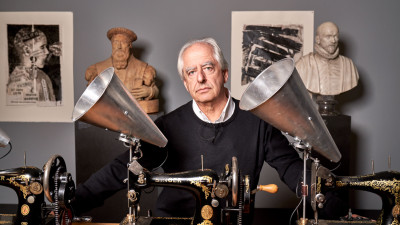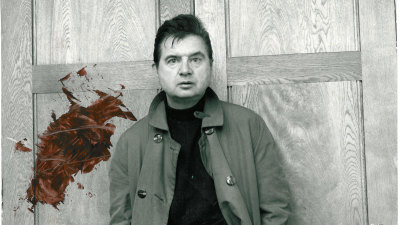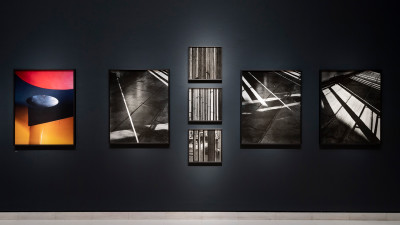On the paper trail of Pablo Picasso
On the paper trail of Pablo Picasso
By Julian Bell
Published 8 January 2020
Antique drawing sheets, Paris metro tickets and lavish wallpapers – the medium of paper was a living ground for the unassailable creative genius of Pablo Picasso. Julian Bell previews our groundbreaking exhibition, Picasso and Paper.
-
From the Winter 2019 issue of RA Magazine, issued quarterly to Friends of the RA. Julian Bell is a painter and writer. His books include What is Painting? and he is co-editor of Ways of Drawing (both Thames & Hudson).
-
How do you follow Guernica? During the summer of 1937, the work – a response to reports of the Luftwaffe’s April onslaught on a Basque town – was exhibited at the World’s Fair in Paris. It prompted fresh surges of cheering and controversy for Pablo Picasso, the pre-eminent celebrity in the art scene. It was gratifying to this most voracious ego to have connected in his mid-50s with the politicised youth of the day, but as a master-operator he might have wished to maintain his independence of mind and distance himself from the claims of the news. Towards the end of that year Picasso stretched another big canvas in the lofty Left Bank attic within which the public picture had been painted in the spring. Its span is narrower than Guernica – a contraction from nearly eight metres to just over four – and yet this far less well-known sequel likewise towers over its viewers imperiously.
Imperiousness has more than one face. Emperors may speak from their balconies, but then they turn back to their courts. Picasso’s Femmes à leur toilette (Women at their Toilette, 1937-38) is court art, as sumptuous and colouristically lush as its predecessor is stark. One factor behind the contrast is that in either case, this artistic monarch was in some sense a servant. If the first arose out of an open-ended commission from Spain’s Republican government, the second responded to a request for tapestry designs that came from Marie Cuttoli, the chief of a Right Bank design house. Cuttoli specialised in modernist luxuries for an elite clientele: her enterprise was to link up the Ancien Régime craftmanship of the weavers of Aubusson with the revolutionary visions of contemporary artists, and Picasso had already enjoyed designing for her, albeit on a much smaller scale.
Here, the better to grapple with the texture of the intended result, Picasso reached back for tactics employed earlier in his career. For tapestry’s dense suffusion of deliberate stitches, he substituted the comparably rich visual overload of fancy wallpapers, reassembled in a cut-and-paste. The methods of Femmes à leur toilette do in fact differ from those of Picasso’s pre-First-World-War collages. Instead of fractured forms, we see unbroken bodies snipped clean out of his rolls from the decorator’s store. Instead of giddy visual puns in which newsprint morphs into violins (Violin, 1912), Picasso deadpans with walls of reproduction masonry and a floor of repro flooring. It is mainly through added charcoalings that Picasso attempts, as he had done in his Cubist days, to scramble the signs so that we approach the faces all ways at once.
-

Pablo Picasso, Femmes à leur toilette, Paris, winter, 1937 - 38.

Pablo Picasso, Violin, Paris, autumn 1912.

Pablo Picasso, Seated Woman (Dora), 1938.
-
“Make for me whatever is personal for you” – that has been the form of many a modern art commission, and it is one with which Picasso here complied. His interior with figures is grandiose but defiantly scruffy. Its bohemian-aristocrat proprietor has been a happy shopper, riffling wallpaper offcuts from all over – cheapo 1930s geometric, floral jollities from the Paul Poiret era, Second Empire crimson-and-gold. He is free with his tastes but he rules over his roost. For Picasso, to think about his personal domain is to think about the women he has loved and about how they interrelate. Accordingly, what these women are likely to be busy with, for the purposes of his reverie, is each other and themselves. To organise this dream harem in Femmes à leur toilette, Picasso leans (as in Guernica) on the reliability of a tripartite composition. Let it revolve around his current amorous obsession – Dora Maar, the 30-year-old artist who had introduced him to the big studio in which he was now working. The flavour of that obsession was bittersweet, a hankering after fascinating discord. Thus, as in Tate’s celebrated Weeping Woman (1937), Picasso casts Dora as a figure of distress for the sake of distress, in stricken dialogue with her spooked reflection. Alongside, holding up the mirror to her, Picasso posits the by-now sidelined Marie-Thérèse – a muse familiar to everyone who visited the astonishing 2018 Tate exhibition Picasso 1932 – Love, Fame, Tragedy. To the other side of Dora, however, Picasso’s thoughts mutate. There’s a notional Olga – his discarded wife, put to service with a comb – but through the corniest of puns, a dress composed of a strip of wallpaper with a pattern of maps, also identifies her as tout le monde, and this “everybody”, it seems, may have better things to turn towards: flowers in a vase, or that blaze of yellow window light. Just possibly, indeed, there might be a world beyond this dream chamber.
Cuttoli never got her tapestry. Picasso wouldn’t allow the big canvas with its pasted papers to leave his studio. (Only 30 years later, aged 86, did he relent, permitting weaving to proceed under alternative direction.) Whether this was because he himself felt the outcome was not satisfyingly resolved, or because he cherished it too zealously, is left to each of us to decide when Femmes à leur toilette arrives in London as the largest single exhibit in the RA’s show Picasso and Paper. How much, anyway, should we look to Picasso – the instigator of the most momentous of all pictorial arguments, that which convulses 1907’s Les Demoiselles d’Avignon – for works of art that are ‘well resolved’? The copious selection loaned to the RA deflects that demand, turning our attention from product to process. As well as exhibiting the sequences of drawings behind major projects, such as Guernica and the Demoiselles (Five Nudes, Study for Les Demoiselles d’Avignon, 1907), the show presents us with an artist who was in many ways an eternal explorative apprentice, pushing the possibilities of every graphic idiom within sight, while slyly subverting each. (“Down with style! Does God have a style?”)
The scope of the RA show is the countless dealings that Picasso had with an indispensable – in fact a fundamental – medium. So there are not only drawings, prints and collages, but costume designs, photography (a medium with which Picasso was considerably engaged), manuscripts of poetry (another with which he dallied), and books, newspapers and envelopes that he modified or defaced. Organised chronologically by the curators Ann Dumas, William Robinson and Emilia Philippot, the survey steers us towards steady but awed appreciation of the energies that we saw so explosively detonated in Tate Modern’s focus on a single melodramatic year. Surprises nonetheless abound: among them, for me, the hip upgrade of tactics Picasso came up with in his late ’60s, when asked to respond to a collection of desolate wartime lyrics by Pierre Reverdy. Le Chant des Morts (1948; opposite top) reproduces the poet’s handwriting festooned with bold mysterious ideograms that the painter has brushed in blood red – not so much as the accompanist to this singer, more in the manner of a bebop player abstractly improvising. (How hard it is, even now, to outpace Picasso! Njideka Akunyili Crosby’s collaged interiors look gorgeously of the moment as the 2010s end, but Femmes preceded them by most of a century.)
-

Pablo Picasso, Five Nudes (Study for Les Demoiselles d'Avignon), 1907.
Watercolour on wove paper. 17.5 x 22.5 cm. Philadelphia Museum of Art: A. E. Gallatin Collection, 1952 Courtesy of the Philadelphia Museum of Art © Succession Picasso/DACS 2019.
-
Picasso drawings pounce, with their analytic vectors and with their sneaky knights’ moves, around whatever is solid, on thought-bottles, desire-guitars, dream-Doras. This is thrilling: these demonstrations of the mobility of intelligence, and of the way it can transcend mere surfaces and styles, are certain to invigorate any viewer, making us wish to pick up pencils likewise. It is also potentially disturbing. There can be a sardonic demeanour to Picasso’s virtuosity, particularly during the so-called “Neoclassical” phase of his career around the time of his 1918 marriage to Olga Khokhlova. And latently, there is the question of what his love consists in, as one woman after another becomes his theme. Picasso may ‘respond’ to Olga, or Marie-Thérèse, or Dora (Seated Woman (Dora), 1938), but his response is always a typecasting; it is as if that individual had been subject to distillation, becoming one more flavour in a tippler’s tour of femininity. For contrast, think of how Madame Cézanne remains obdurately unknowable, however often painted by one of Picasso’s heroes. An evening with the charismatic Spaniard, one suspects, would have been much more fun. Yet there is something to be said for respecting the self-sufficiency of other persons.
Love is no simple thing. Picasso accumulated possessions throughout his life, in heaps that grew more daunting with each change of studio. John Richardson’s memoir, The Sorcerer’s Apprentice (1999), pictures the clutter of chairs, hats, mirrors, masks, bronzes, tribal carvings and opened envelopes that filled La Californie, the Côte d’Azur villa where Picasso settled in his 70s. To the charge that his habit is a disease, the hoarder might reply that it is a compassion. If his attention alights on some curio, he recognises the life in it. He salutes it as a precious seed of information and intention, and he reserves the possibility that some day, it may get its chance to bloom. It is not for him to snuff it out. The rationale may seem preposterous, but we owe to it this exhibition. The central quantity in that hoard was the artist’s own oeuvre, to which in his later years he took an encyclopaedist’s approach, dating every single graphic act he completed. “Some day there will undoubtedly be a science… which will seek to learn more about man in general through the study of creative man,” Picasso remarked to Brassaï. “I often think about such a science, and I want to leave to posterity a documentation that will be as complete as possible.”
With his death in 1973, the great pile was left in the hands of Picasso’s heirs. From them it eventually passed in its entirety to the Musée national Picasso-Paris, which was first opened in 1985. Working with the museum, the curators of the RA show have sifted from that daunting information overload an intelligible 11-gallery selection, taking us through from a little dove torn out of paper by a nine-year-old in La Coruña to the last self-portrait of a 90-year-old working in a studio outside Cannes. If the tour leads us to gasp at one man’s dexterity and mental power, it might also prompt thoughts about his hubris. Underpinning the whole enterprise, arguably, lies the conviction that Picasso himself is humanity’s prize specimen, and thus that whatever he turns towards – symbols, sitters, patrons – folds back into the labyrinth of his own psychology. But this could be upended. There was a star system anyhow, during the times through which Picasso lived, and he happened to be best qualified to fall into its key role: its dupe, almost. There is room to laugh at the poseur who gets himself photographed by his friend Brassaï in front the Femmes in the likeness of a magus. Moreover, work by work, the selection coming to London is hardly overbearing. They’re only sheets of paper, after all: lightweight, disposable stuff that is prevailingly bright.
-
-

This is a venture that is less intent on bombarding us with masterpieces than on “illuminating the creative processes of one of the most inventive artists of the modern era,” as William Robinson puts it in the exhibition catalogue. And yet masterpieces cannot but sidle up. There is a feast of sublime etchings – notably those featuring the self-styled minotaur who presides over that personal labyrinth (Minotaur Caressing the Hand of a Sleeping Girl with its Muzzle, c.1933-34). There are also the works in which Picasso most wittily induced paper to think about paper, things done an approximate decade before his death. Just before he turned 80, with his estranged wife Olga now dead, Picasso had finally married again and settled down contentedly with the most compliant of all his objects of obsession, a junior to him by 46 years named Jacqueline Roque. This was the point at which he dreamt up a large public sculpture based on Manet’s Le Déjeuner sur l’herbe – one of a long succession of variations on his artistic forebears – by cutting and bending card maquettes to be upscaled for casting in concrete. But I’m most struck by an almost weightless jeu d’esprit with which he celebrated his new bride.
Think of paper as a bright expanse: then his Tête de Femme (Head of a Woman, 1962) is a conversation between three ways you might interrupt that expanse. Pen lines and scissor cuts dance around one another while both dance around the shadows that are cast by the folding of the sheet. “Negative space” has never felt so sensuous: in fact the piece persuades us that there is no such thing, for every sort of space, if only we could see the way Picasso could see, is pregnant with significance. Love may not be simple, but in a sly and flimsy fashion, it supplies us here with a small glimpse of paradise.
-
-
Picasso and Paper is in the Main Galleries from 25 January — 13 April 2020. Exhibition organised by the RA and the Cleveland Museum of Art in partnership with the Musée national Picasso-Paris. Lead Supporter City of Malaga.
-
-
Enjoyed this article?
Become a Friend to receive RA Magazine
As well as free entry to all of our exhibitions, Friends of the RA enjoy one of Britain’s most respected art magazines, delivered directly to your door. Why not join the club?

-









